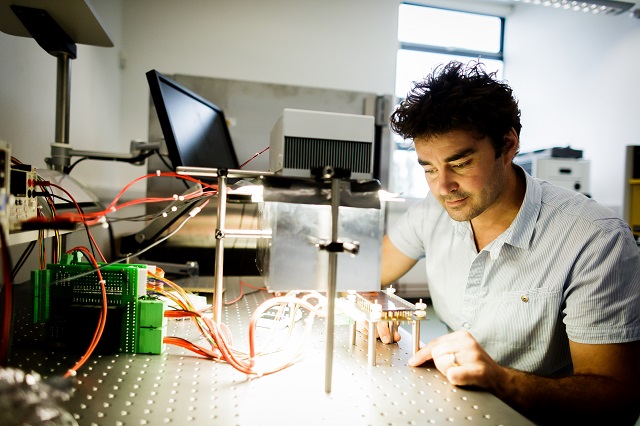Jan 31 2014
 Henry Snaith CSO at Oxford Photovoltaics
Henry Snaith CSO at Oxford Photovoltaics
Advances in solar technology are set to revolutionise the Building Integrated Photovoltaic (BIPV) market with the development of a new type of cells which combine semi-transparency with good efficiency, opening up the possibility of entire facades formed of electricity generating glass. A paper in the prestigious American Chemical Society (ACS) journal ACS Nano, by Oxford University physicist and Oxford Photovoltaics co-founder Professor Henry Snaith and his team, charts the development of alternatives to crystalline silicon photovoltaics, describing how the original ‘new generation’ technology based on organic or dye-sensitised solar cells achieved the semitransparency that is desired by designers and developers of buildings, but was unable to achieve efficiencies close to crystalline technology.
Now, however, Professor Snaith and his team at the University have developed solar cells using perovskite. These solar cells have achieved efficiencies over 15% in the last 12 months, overtaking other emerging solar technologies which have yet to break the 14% barrier despite decades of research.
Most significantly, the team has also found a solution to the reddish-brown tint previously associated with the use of perovskite to produce neutral coloured, semi-transparent cells which address the needs of the construction industry. This world-leading research is being brought to market by Oxford Photovoltaics (Oxford PV), which holds an exclusive license to the technology. Oxford PV scooped a number of awards for its progress in the commercialisation of the technology during 2013 including the British Renewable Energy Association’s Innovation Award, the UK Business Angels’ Best Early Stage Investment in a Disruptive Technology Business Award and the Solar Award for Excellence: BIPV Innovation at the 2013 Solar UK Industry Awards
In December last year, Nature magazine identified Professor Snaith, Oxford PV’s Chief Scientific Officer, as one of the ten people who made a difference to science in 2013.
Commenting on this latest breakthrough he said: “The pace of development, of this new solar technology, alongside ongoing research into storage solutions, means that photovoltaics will play an increasingly important role in meeting future energy demand globally.”
Oxford PV Chief Executive Kevin Arthur added: “We’re making great progress towards commercialisation of this ground-breaking technology and expect to sign our first licensing deals early next year.
This research also emphasises the importance of nurturing links between business and academic institutions. Our sponsorship of PhD students delivers extra capacity to push our work through faster and builds a pipeline of great talent for our company. All of this will help the UK become a world leader in the multi-trillion pound electricity generation industry. ”
www.oxfordpv.com